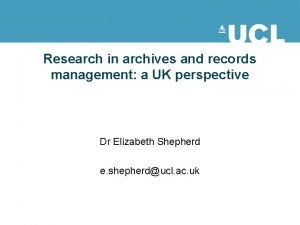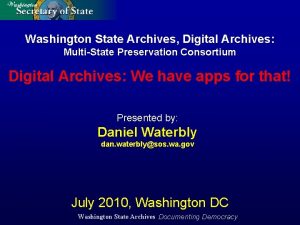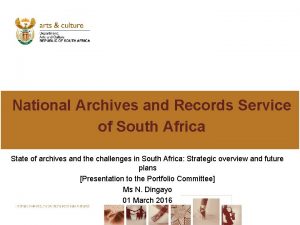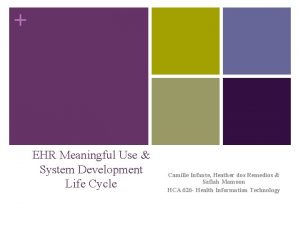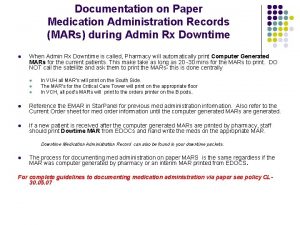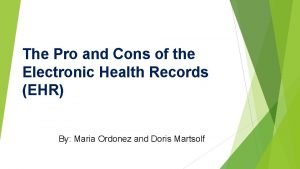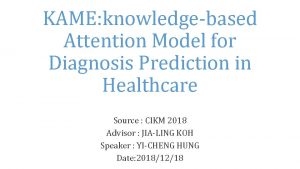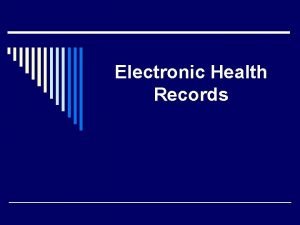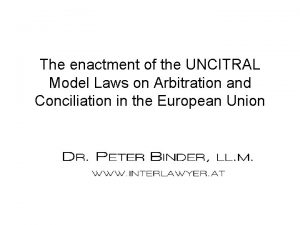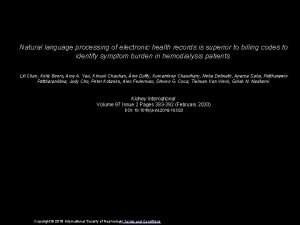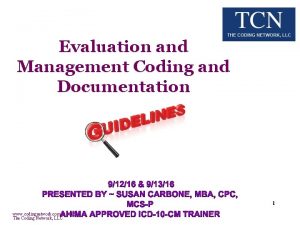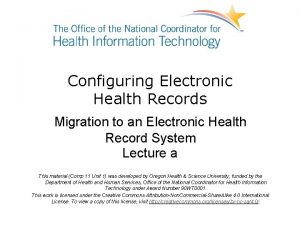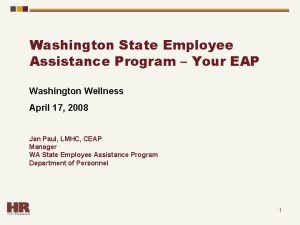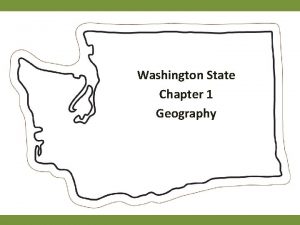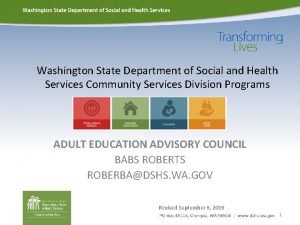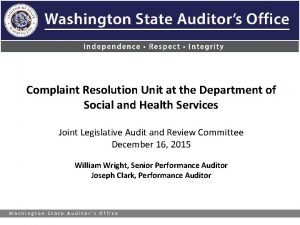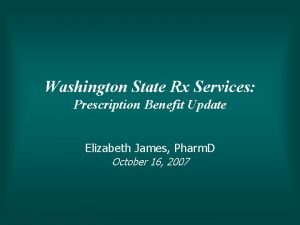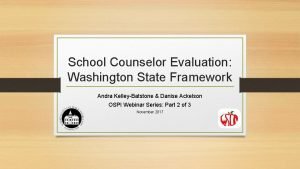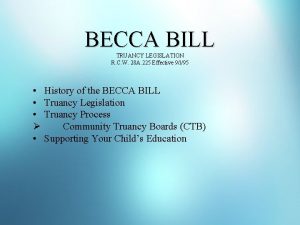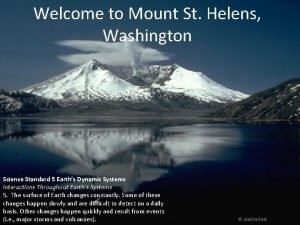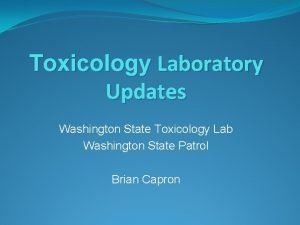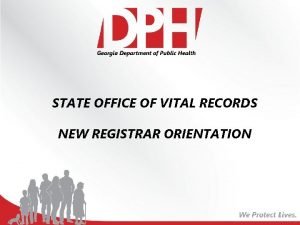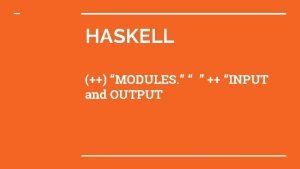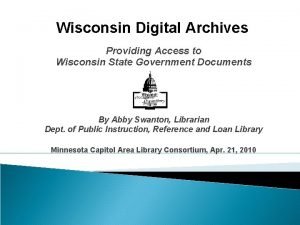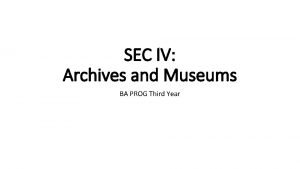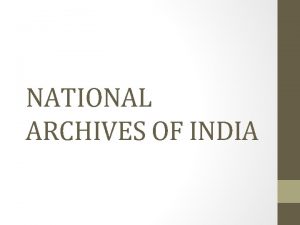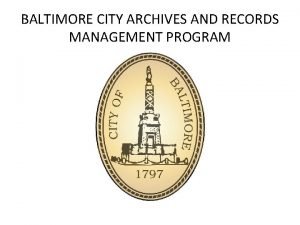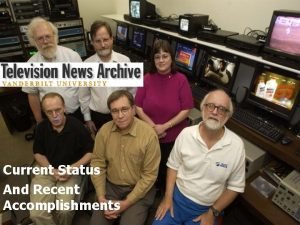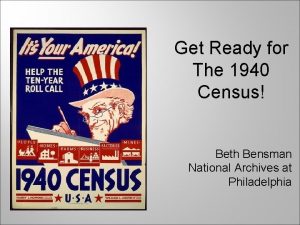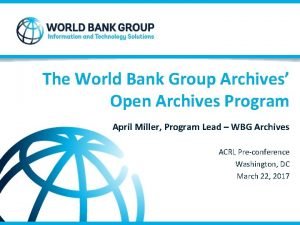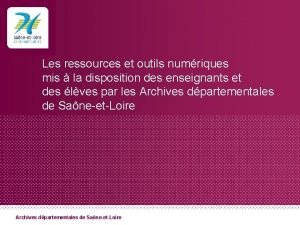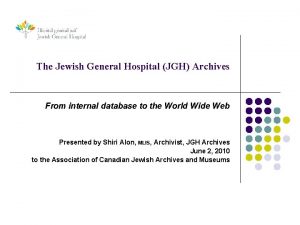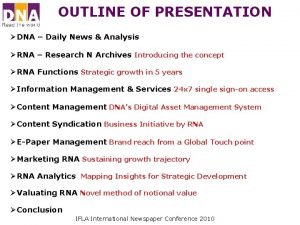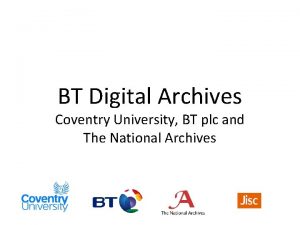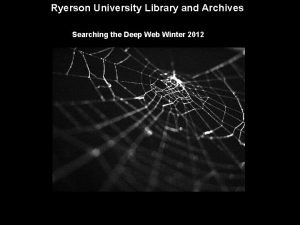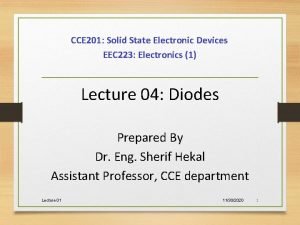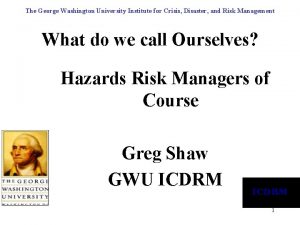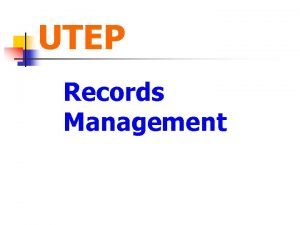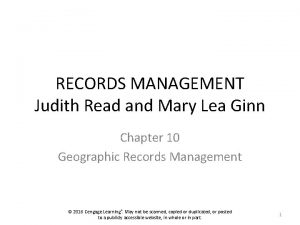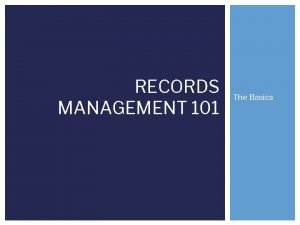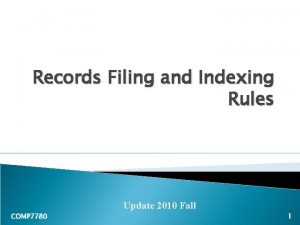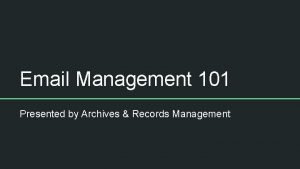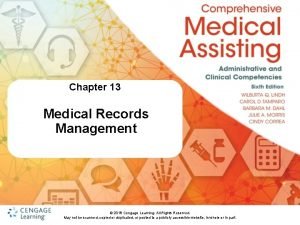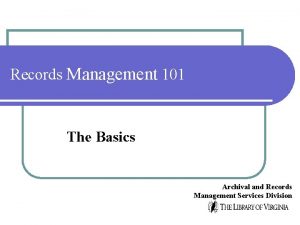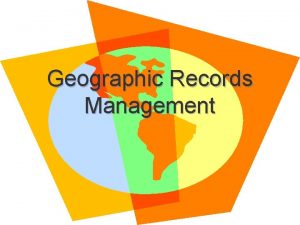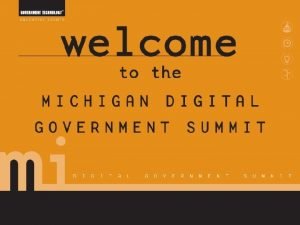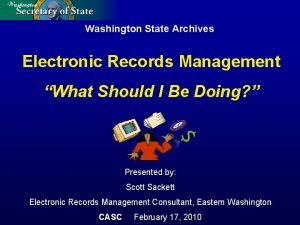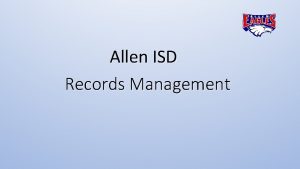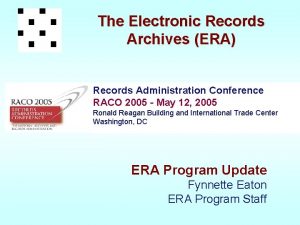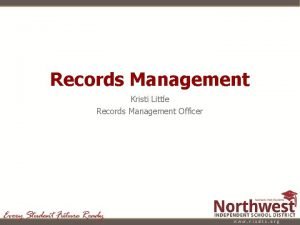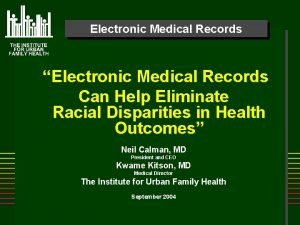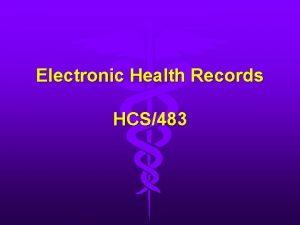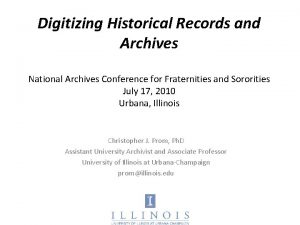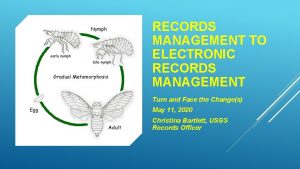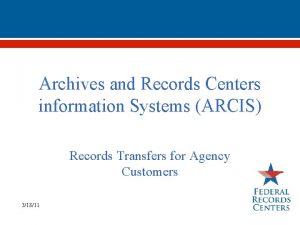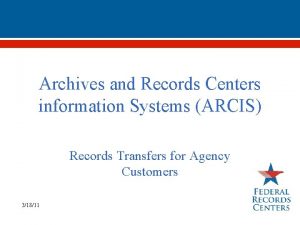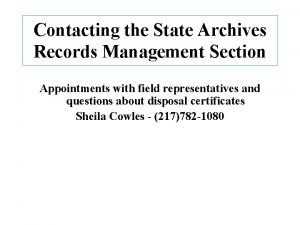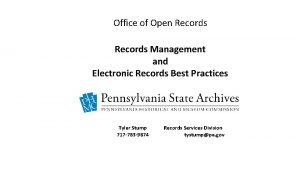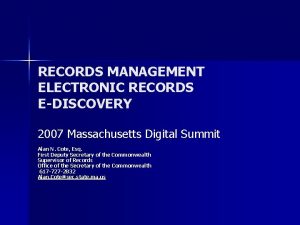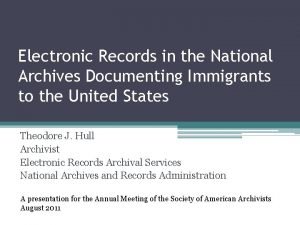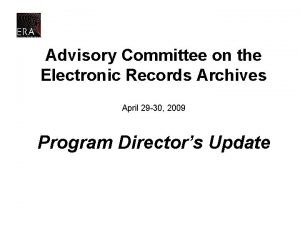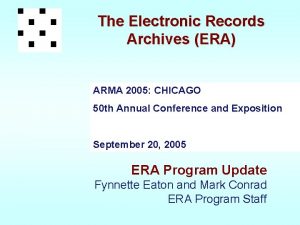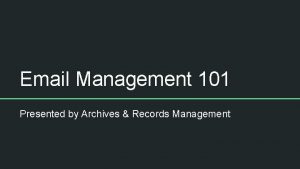Washington State Archives Electronic Records Management Put Out

















































































- Slides: 81

Washington State Archives Electronic Records Management : Put Out The Fire! Presented by: Leslie Koziara, CRM, ERMP Electronic Records Management Consultant leslie. koziara@sos. wa. gov 360 -586 -4893

Overview • Requirements for Public Records • Requirements and Guidelines (by format) – Scanned Documents – Email – Websites and Databases – Texts, Social Media and more! • The Digital Archives

RCW 40. 14 Preservation and Destruction of Public Records “Public records include any paper, correspondence, completed form, bound record book, photograph, film, sound recording, map, drawing, machine-readable material, compact disc meeting current industry ISO specifications, or other document, regardless of physical form or characteristics, and including such copies thereof, that have been made by or received by any agency of the state of Washington in connection with the transaction of public business”

Protect your public records RCW 42. 56. 100 Protection of Public Records …” to protect public records from damage or disorganization, ………. Such rules and regulations shall provide for the fullest assistance to inquirers and the most timely possible action on requests for information. ……”

WHAT IS A RECORD? QUIZ # 1 Fire Station #4 is called to the scene of an accident. A firefighter take a digital photo of the incident. Is this photo a public record? □ Yes □ No

WHAT IS A RECORD? QUIZ # 2 In your desk drawer, you have a copy of the contents of your personnel file. It contains duplicates of your application, training taken, awards received, etc. Is this a public record? □ Yes □ No

WHAT IS A RECORD? QUIZ # 3 You come back to your desk following lunch and your computer indicates that you have two email messages waiting for you. A. ) One message is from the assistant fire chief requesting shared leave for a colleague on extended sick leave. B. ) The other message is from your boss, giving you the agreed-upon timelines and goals for an upcoming project. Which message is a public record? □ A only □ Both A and B □ Neither A nor B

WHAT IS A RECORD? Quiz # 4 Fire District #9 has Facebook and has invited public comment on a proposal for a new fire station. Is this a public record? □ Yes □ No

Preservation of Electronic Records WAC 434 -662 -040 Electronic records must be retained in electronic format and remain usable, searchable, retrievable and authentic for the length of the designated retention period.

Designated retention period? Huh? • If you are new to RM, there is a document for managing public records for retention and disposition is called a “retention schedule” • Each agency will use two schedules: – CORE (Common Records) – Fire and Emergency Sector Schedule (under development)

Regardless of format – use for both paper and electronic records • Retention schedules tell you: – What types of records (grouped by record series) you are required to keep – How long you are required to keep them – What to do with the records once retention has been met: • Destroy (roughly 95% of the time) • Transfer to Archives (roughly 5% of what’s left)

“Defensible Disposition” Retention schedules are legal documents and provide agencies with the authority to get rid of records once retention has been met

Approved schedules available online www. sos. wa. gov/archives Click on: Local Government Services Then: Retention Schedules

Can I Print and Then Delete Electronic Records? NO - Printing and retaining a hard copy is not a substitute for the electronic version unless approved by the appropriate records committee.

Why Printing Doesn’t Work • Metadata associated with “born digital” records establishes and preserves the authenticity of the record which is the evidence of the transaction it documents. • Printing electronic records (e. g. emails) preserves the informational content but not the authenticity of the record.

What is a “Born Digital” Record? • Regardless of how it was created: – If the transaction or evidence of public business occurs in paper then the paper record needs to be retained. – If the transaction or evidence of public business occurs electronically then the electronic record needs to be retained. Washington State Archives Documenting Democracy

What is “Born Digital”? #1 – Minutes are drafted using Microsoft Word and then printed. – Chair signs the printed minutes at the next meeting. – Transaction of public business occurs in paper so the signed paper minutes need to be retained. Washington State Archives Documenting Democracy

What is “Born Digital”? #2 – Agendas are drafted using Microsoft Word. – Agendas are distributed to Committee members via email with the Word attachment. – Transaction of public business occurs electronically so the email and attachments need to be retained. Washington State Archives Documenting Democracy

Digitized Records Can I Scan and Toss? “Conversion to an imaging system does not automatically authorize the destruction of the source documents for which images have been created. ” WAC 434 -663 -600 Washington State Archives Documenting Democracy

“Scanning and Tossing” Requirements • Requirements document just released March 9, 2012. • No longer have to seek approval from Washington State Archives - nothing needs to be submitted • If agency determines that its procedures for scanning and managing the records meet or exceed the requirements in the standard, the agency may destroy Non-Archival source records after they have been scanned and verified. Washington State Archives Documenting Democracy

“Scanning and Tossing”: Primary Concerns • Are the records designated Non-Archival? • Are the records being scanned in a way that ensures a complete, accurate, and durable copy? • Will the images be accessible and protected from unauthorized deletion/alteration for the entire required retention period? Washington State Archives Documenting Democracy

Managing Electronic Records

Why not just keep it all? Consider this: • Think needle in a haystack. . less hay, easier to find the needle - less costs for discovery and disclosure • Yeah, storage is cheap, litigation is NOT • Other associated costs: – Additional space needed (equipment and facility) – Additional maintenance and staffing needed – Additional upgrades, increased migration & recopying, disaster planning – Additional long-term sustainability issues

So where do you start? • First responders need to establish agency records management policies & procedures – – Requires executive buy-in and input from legal Identifies roles and responsibilities Should address appropriate use Include records management fundamentals • Need user and IT support • Training and education are essential • Periodic compliance checks are crucial – Automatic deletion is not recommended!

Put out the fire Successful organization and control is a win–win situation • Agency benefits in lower costs and more efficient operations • Employees benefit with better access and increased productivity • Public benefits with transparency and prompt responses to any requests

A winning strategy for electronic records • Identify • Organize • Disposition (take action)

Identify Using approved records retention schedules will help you: • Identify records you need to keep • Identify records you can get rid of • Identify records needing additional attention: üEssential üArchival

Use RM to identify improvements to process • Do an analysis on what processes may be eligible for consolidation and streamlining • Another way to save money – Look at ways to go “paperless” – Look for ways to improve a process • Just because that’s the way it’s always been doesn’t make it better • How much duplication is there? • How much time and energy does something take?

Organize Using what you have • Agencies already have established files for their paper records, use what has already been developed and adapt to “electronic” filing systems • Retention schedules already exist • Also serves as excellent preparation prior to implementing any automated processes

File it – it’s not just for paper

Create a plan • Create a “file plan” or “file structure” • Link to retention schedules • Pre-determined file folders provide consistency, centralization and organization • Mirror the plan throughout – use same structure for paper, email, desktop, network drives and servers • Develop desk guides and cheat sheets

Disposition- Do it! • Organize to destroy • Apply same retention and disposition practices to electronic records as you would paper based records • Regularly schedule disposition to clear out those items having met retention and get rid of them! • Sweep out the garage!

Electronic Record Life Cycle CONSIDER CONTENT Create or Receive Record DESTROY and document destruction If NO retention value Delete Record / Save When retention is met, ID records for destruction Non-Archival Approve for destruction Properly ID Keep until retention met If Archival Transfer

Little or no retention Local Government Agencies

Organizing Emails – Option 1 Within email application • Individual users move e-mails into predetermined folders that match those on server or shared drive • Good to set up as “working files”, or for records with minimal retention value • Recommend records with significant retention value be retained on drives or servers

For example Additional folders can be set up to further define the content – easy to locate and search, under DAN # GS 22005 Mirror this structure on shared drive or server for records with retention value

Another example Outlook file structure

Organizing E-mails – Option 2 Using shared drive or network server • Designated shared drive or server is used as centralized “file cabinet” or repository • Users save their emails into predetermined folders in specific “drawers” • Users can access in a centralized location • Generally no active retention or disposition applied, but can set up system administrators to track and disposition

Can look like this Training (Conferences & Seminars GS 22005 Create file “drawers” and create appropriate folders in a server or shared drive “electronic file cabinet” Marry up with appropriate retention schedules and mirror pre-set email folders

Next click Create appropriate file “drawers” and create the folders as necessary in which to “file” your information – all of these are still GS 22005

Email regarding meeting room contract By using the. msg extension, it can saves record copy emails electronically and preserve the metadata as well – also will save attachments Using classifications and naming conventions make it easier to search and locate the information

Email saved using. msg extention in server along with other formats Drag and drop

BBy using the. msg extention, you are able to save emails along with all the other formats together in one place under one record series, all under the same retention and manage it as a whole instead of bits and bytes One place, one folder, one retention

Another example

Local Gov’t CORE

An example Additional file folders can be created as necessary under each record series Additional records series under a category can be added

Local Govt CORE

Local Gov’t CORE

Fire and Emergency

Example file plan

Law Enforcement

This series is ARCHIVAL - 9 year retention for agency, then transfer to archives You may create and protect folders as exempt or confidential

What About Text Messages? • Content is key – are you conducting business? • Have policies regarding use of texts • Agency responsibility to capture texts that need retention according to approved schedules • 3 rd party tools/applications available Cannot rely on provider to retain!

Helpful hints • Use existing retention schedules! • Consult with users, enlist their input • Work on keeping file names short and simple, yet make sense to users • Keep it under 255 characters & spaces, otherwise may have problems with access and retrieval

What About Websites? Records Retention – 3 areas 1. Website Design/Architecture 2. Website Content 3. Changes to Website Content

Website Design / Architecture • Records documenting the technical design and structure of website – the look and feel of your website • Includes connection between the website and other databases and applications • Webpage style templates

Content • Typically, website content falls into these main categories: 1. Secondary Copies of Other Public Records 2. Database-Driven Content 3. Advice / Information


Secondary Copies - Retention • How to apply retention: – Manage the agency’s primary copy – Use appropriate record series based on the function and content of the record – Treat web version as secondary copy

Contains secondary copies of approved retention schedule

Content – Database-Driven • How to apply retention: – Manage the record within the database as the agency’s primary copy – Use appropriate record series based on the function and content of the record – Records documenting the rules governing database / website interaction are covered by website design

Online registration - database Conferences and Seminars GS 22005 3 years after date of event Information is generated through web form and put into a database Website is only place this record is generated

Why Document Changes • It is not enough to just know what you said (the content) • Agencies also need records documenting when did we say it and when did we stop saying it (the context to the content)

Capturing websites It depends on the complexity of website Options include: • Snapshots • Email confirmations/webmaster • Change logs/audit logs • Maintaining entire site • 3 rd party software for ECM – Drupal, Cold. Fusion, Alfresco

What about databases? • Apply same principles as websites – Based on content and function of database – Is it a repository of information held elsewhere? – Does it contain evidence of business transactions not found in another format? – Is the database dynamic with continuous changes, updates?

Capturing databases It depends on the complexity and function of database Options include: • Change logs/audit logs • Maintaining entire database • 3 rd party software for ECM

Do you?

Points to ponder Ask some questions: • Make a business case for use – do you really need to add another “technology du jour”? • Check with legal counsel • Check out terms of service agreements

TOS Agreement = Contract • • • Security, identity “hijacking” Indemnity issues Privacy, data ownership Rights of company to edit/display/advertise Addressing merger/acquisitions Will use meet overarching regulations? – FOIA, ADA, RCW’s, WAC’s

Hot off the press • Facebook now has state and local government terms of service agreements • Go to very bottom of first Facebook page– click on Terms • Go to very bottom again – click on Pages Terms • Go to very bottom again – click on Amended Pages Terms for State and Local Governments in the United States


Tips and tools to aid social media retention • Series of email exchanges on content, when posted, when withdrawn, updates, etc. • 3 rd party software or content management systems ü Tw. Inbox ü Tweet. Take ü Social. Safe

Going to the cloud Issues to consider: • Custody • Co-mingling of data (will probably not be held separately from others using storage server) • Privacy, security / hijacking of information • Data transmission/flow (Where is the server, exactly? • Disaster preparedness and recovery

Clouding the issue • What about the vendor: – How stable? What’s their history? – Do they outsource or sub-contract ? – How proprietary are their applications? – Their hiring practices for employment? Are there background checks, etc? – Their overall audit / security processes? – Can your rules apply?

Introduction to the Digital Archives • Opened in 2004 in Cheney, WA 2005 3. 5 million records 2006 6 million records 2010 92 million records 2011 100 million and adding daily!

Digital Archives Value • Access and convenience • Reduce agency workload • Limited business resumption • Digital Archives migration strategy There is no charge for any of this!

Transferring Your Records Part 1: Set It Up • Consultation ü Call your regional consultant • Forms Generation ü Transfer Agreement and Plan • Transfer ü Secure SFTP or Hard Drive • Ingestion ü Security and error checks

Transferring Your Records Biggest Challenge Biggest challenge to the Digital Archives: Multiple proprietary formats! When purchasing an electronic records management system, please let your vendor know that the Digital Archives has an acceptable data export format. We will be glad to work with your vendor so that we can preserve your records.

In conclusion… Explore available options, and adapt them to best serve agency needs and usage – Establish policies, procedures, ground rules – Take time to fully develop file structures and plan, plan for implementation – Keep it as simple as possible – Education, training, and more training – Lots of patience (Chocolate helps!)

Questions? Records Management Helpdesk recordsmanagement@sos. wa. gov Subscribe to listserv for the latest updates http: //www. sos. wa. gov/archives/ Records. Management/

Records Rule! Thank You! Washington State Archives: Partners in preservation and access www. sos. wa. gov/archives
 Put out the light and put out the light
Put out the light and put out the light Ucl archives and records management
Ucl archives and records management Ducumom
Ducumom Naairs south africa
Naairs south africa You put your left foot in you put your left foot out
You put your left foot in you put your left foot out One direction one thing
One direction one thing Central washington hospital pharmacy
Central washington hospital pharmacy System development life cycle of electronic health records
System development life cycle of electronic health records Paper medication administration record
Paper medication administration record Electronic health records pros and cons
Electronic health records pros and cons Electronic health records
Electronic health records Paper vs electronic medical records
Paper vs electronic medical records Uncitral model law on electronic transferable records
Uncitral model law on electronic transferable records Electronic medical records
Electronic medical records Natural language generation for electronic health records
Natural language generation for electronic health records Electronic medical records
Electronic medical records +electronic +health +records +migration
+electronic +health +records +migration An electronic is the electronic exchange of money or scrip
An electronic is the electronic exchange of money or scrip Electronic news gathering and electronic field production
Electronic news gathering and electronic field production Washington state employee assistance program
Washington state employee assistance program Washington state geography
Washington state geography Medicare vs medicaid washington state
Medicare vs medicaid washington state Washington state rn licensure
Washington state rn licensure Washington biomes
Washington biomes Wa state apprenticeship programs
Wa state apprenticeship programs Washington state dairy council
Washington state dairy council Wheres washington state
Wheres washington state Washington state department of social and health services
Washington state department of social and health services Washington state radon map
Washington state radon map Washington state social emotional learning standards
Washington state social emotional learning standards Complaint resolution unit washington state
Complaint resolution unit washington state Washington rx services
Washington rx services School counselor evaluation rubric
School counselor evaluation rubric San diego regional science olympiad
San diego regional science olympiad Becca's law
Becca's law Washington state board of technical and community colleges
Washington state board of technical and community colleges Washington state women's prison
Washington state women's prison Geography washington state
Geography washington state Washington dream ahead
Washington dream ahead Iiepay
Iiepay Futuristic nursing
Futuristic nursing Washington state migrant council
Washington state migrant council Washington state patrol toxicology lab
Washington state patrol toxicology lab Washington state transit insurance pool
Washington state transit insurance pool Gavers vital records
Gavers vital records Haskell input output
Haskell input output Covilib
Covilib National archives gb rail 253/516
National archives gb rail 253/516 Archives and museums du study material
Archives and museums du study material Write a short note on national archives of india
Write a short note on national archives of india Baltimore city archives
Baltimore city archives Religious archives examples
Religious archives examples Tv news archives
Tv news archives Indots
Indots Motherwell times archives
Motherwell times archives Edhint
Edhint The world bank
The world bank Interim archives
Interim archives Www.archives.71fr
Www.archives.71fr Jewish general hospital archives
Jewish general hospital archives Dna mumbai epaper
Dna mumbai epaper Coloured gemstones working group archives
Coloured gemstones working group archives Library and archives canada
Library and archives canada Bt digital archives
Bt digital archives Ryerson library and archives
Ryerson library and archives National archives
National archives Sheffield telegraph archives
Sheffield telegraph archives Solid state electronic devices 7th solution chapter 4
Solid state electronic devices 7th solution chapter 4 Solid state electronic devices ppt
Solid state electronic devices ppt Professional portfolio management tim washington
Professional portfolio management tim washington George washington crisis management
George washington crisis management Records management mission statement
Records management mission statement Records management mary l. ginn
Records management mary l. ginn Records management 101
Records management 101 Indexing unit example
Indexing unit example Email
Email Records management disaster recovery plan
Records management disaster recovery plan Chapter 13 medical records management workbook answers
Chapter 13 medical records management workbook answers Record management 201
Record management 201 Records management 101
Records management 101 Geographic records management
Geographic records management Debbie gearhart
Debbie gearhart

